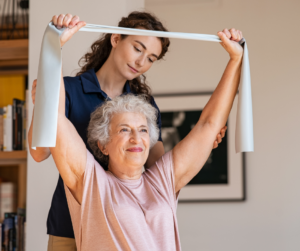Preventing Muscle Loss in Seniors
 Maintaining muscle mass becomes more crucial for general health and life satisfaction as we get older. Sarcopenia, or the loss of muscle, can cause reduced strength, problems with mobility, and an increased risk of fractures and falls. Fortunately, seniors who have access to home care assistance can avoid muscle loss and maintain their strength and activity level well into old age by utilizing some of the techniques discussed below.
Maintaining muscle mass becomes more crucial for general health and life satisfaction as we get older. Sarcopenia, or the loss of muscle, can cause reduced strength, problems with mobility, and an increased risk of fractures and falls. Fortunately, seniors who have access to home care assistance can avoid muscle loss and maintain their strength and activity level well into old age by utilizing some of the techniques discussed below.
Understanding Sarcopenia
Sarcopenia is the age-related progressive loss of strength and muscular mass. While it starts at an earlier age, its effects continue through the older years. Hormonal fluctuations, a decrease in physical activity, and poor nutrition are contributing factors. Resolving these issues can greatly reduce the loss of muscle mass.
Tips for Maintaining Muscle: Physical
The best treatment for sarcopenia is strength training. It includes workouts like weightlifting, resistance band exercises, and body-weight exercises (e.g., push-ups, squats) that force muscles to contract against resistance. It’s important for seniors to begin with smaller weights and raise the resistance progressively as their strength increases. They should be encouraged to complete two or three workouts a week that focus on all the main muscle groups. With home care assistance by their side, they can also gain tips for using household items such as canned goods as weights.
Aerobic exercise can also help seniors, as it enhances cardiovascular fitness and stamina. Seniors can be encouraged to try things like cycling, swimming, and walking, which are all beneficial for general health and the strength training mentioned above. They should aim for at least 150 minutes a week of moderate-to-intense aerobic exercise for seniors.
Finally, seniors can also work on flexibility and balance workouts, such as tai chi and yoga, among other things, to help prevent falls and maintain joint health. These exercises improve muscle coordination and flexibility, both of which are essential for daily tasks.
Diet: Providing Energy for Maintaining Muscle
Seniors with home care assistance can gain valuable help with their diets, from meal planning to learning how to cook new foods. When trying to maintain muscle mass, they can also use the following food techniques:
- Focus on Protein Intake: Consuming enough protein is essential for both muscle growth and repair. Depending on their degree of exercise, seniors should aim for 1.2 to 2.0 grams of protein per kilogram of body weight every day. Lean meats, seafood, dairy products, legumes, and plant-based proteins are all excellent sources.
- Calcium and Vitamin D: These two elements are essential for bone health, which subsequently promotes muscle performance. Supplements, fortified foods, and sun exposure can all help keep levels at an appropriate level. Seniors who are unsure of the proper dosage should speak with their healthcare physician.
- Hydration: Dehydration can hinder the healing and functionality of muscles. Water, herbal teas, and other non-caffeinated beverages should be the primary sources of fluids for seniors throughout the day.
- Anti-Inflammatory Diets: Prolonged inflammation can hasten the loss of muscle mass. Consuming anti-inflammatory foods such as nuts, berries, leafy greens, and fatty fish can help reduce the risk of inflammation.
The tips above can help seniors prevent muscle loss, which can improve their quality of life. Additionally, when home care assistance is in place, they gain the encouragement they need to continue using the tips for the utmost consistency.
